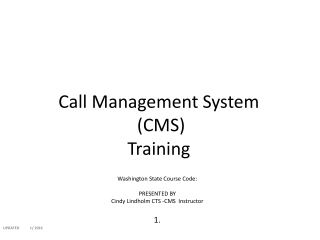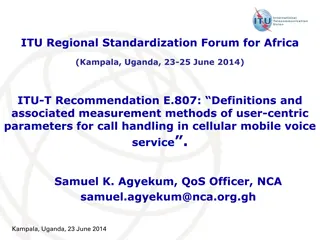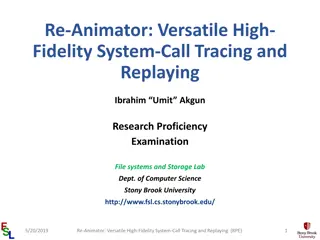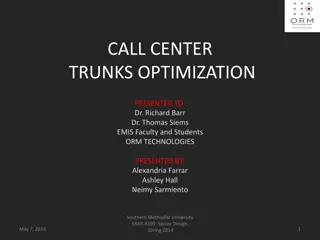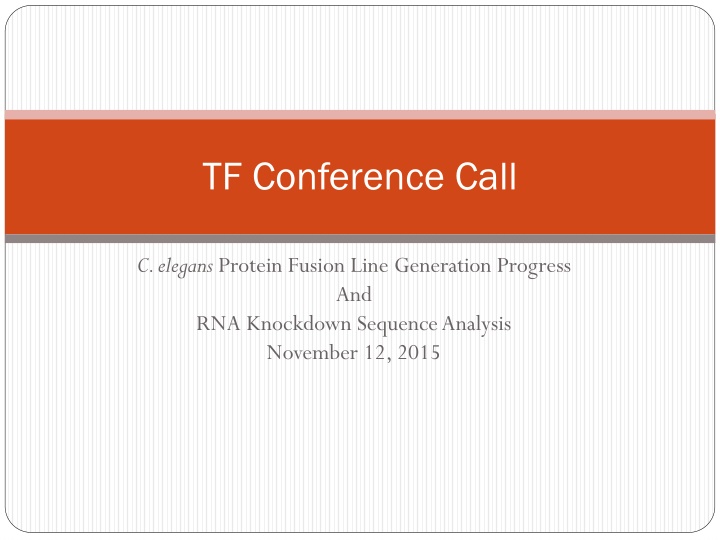
C. elegans Protein Fusion Line Progress & Analysis
"Explore the progress of C. elegans protein fusion line generation, RNA knockdown sequencing, TF targets, active TFs, and quarterly summaries. Dive into the research journey starting from November 12, 2015, to Year 4, Quarter 1 dated Nov 6."
Download Presentation

Please find below an Image/Link to download the presentation.
The content on the website is provided AS IS for your information and personal use only. It may not be sold, licensed, or shared on other websites without obtaining consent from the author. If you encounter any issues during the download, it is possible that the publisher has removed the file from their server.
You are allowed to download the files provided on this website for personal or commercial use, subject to the condition that they are used lawfully. All files are the property of their respective owners.
The content on the website is provided AS IS for your information and personal use only. It may not be sold, licensed, or shared on other websites without obtaining consent from the author.
E N D
Presentation Transcript
TF Conference Call C. elegans Protein Fusion Line Generation Progress And RNA Knockdown Sequence Analysis November 12, 2015
Overview Generation of C. elegans lines RNA Knockdown Sequencing STAR and BitSeq overview
TFs and Fosmids 924 TFs (Reece-Hoyes et al 2005). There are 712 Active/Complete TF Targets. 205 of them are nhrs that we have decided not to pursue 7 have been discontinued due to a lack of nuclear expression 712 Targets 317 Complete TF s 163Targets with no tagged fosmid 232 TF s actively in our pipeline
Active TFs 232 Active TF s 128 genes are pending DNA preps 37 genes pending Bombardment 34 genes are pending Rescue/Screening 16 genes are pending Expression Screening 17 genes need to be reevaluated
Year 3 Rescues Dec 11 Dec 30 Feb 18 Oct 15 Jan 28 Feb 11 Feb 25 Mar 11 Mar 25 Jan 21 Oct 2 Oct 8 Oct 22 Oct 29 Nov 5 Mar 4 Dec 4 Apr 15 Apr 22 Sep 30 Jul 22 Aug 5 Aug 12 Aug 19 Aug 26 Sep 9 Sept 23 Apr 1 May 6 May 13 May 20 May 27 Jun 2 Jun 10 Jun 17 Jun 24 Apr 8
Bombardment Trends Number of Constructs Bombed Average = 8.5 16 14 12 10 8 Number of Constructs Bombed 6 4 2 0 4-Dec 4-Jan 4-Feb 4-Mar 4-Apr 4-May 4-Jun 4-Jul 4-Aug 4-Sep 4-Oct Rescues 160 Average = 48.3 140 120 100 80 Rescues 60 40 20 0 4-Dec 4-Jan 4-Feb 4-Mar 4-Apr 4-May 4-Jun 4-Jul 4-Aug 4-Sep 4-Oct
Year 3 Summary Number of constructs bombed = 290 Number of rescues generated = 1561 ~25% of the 6090 plates screened contained rescued worms. Number of rescues screened for expression = 263 ~16% of generated an integrated line Number of lines generated = 73 (54 unique) ~27% of integrated lines have expression ~5% of rescues produce an integrated expressing line
Year 4, Quarter 1 Oct 9 Oct 16 Oct 23 Oct 30 Nov 6
Quarter Number of lines Lines Line Generation by Quarter Yr1 (1Oct 2012 30Sept 2013) OP492, OP493, OP494, OP495, OP496, OP497, OP498, OP499, OP501, OP502, OP503, OP504 12 OP505, OP506, OP507, OP508, OP509, OP510, OP511, OP512, OP513, OP514, OP515, OP516, OP517, OP518, OP519, OP520, OP521, OP522, OP523, OP524, OP525, OP526, OP527, OP528, OP529, OP530, OP531, OP532, OP533, OP534, OP535 OP536, OP537 , OP538, OP539, OP540, OP541, OP542, OP543, OP544, OP545, OP546, OP547, OP548, OP549, OP550, OP551, OP552, OP553, OP554, OP555, OP556, OP557, OP558, OP559, OP560, OP561, OP562, OP563, OP564, OP565, OP566, OP567, OP568, OP569, OP570, OP571, OP572, OP573, OP574, OP575, OP576, OP577, OP578, OP579, OP580, OP581, OP582, OP583, OP584, OP585, OP586, OP587, OP588, OP589, OP590, OP591, OP592, OP593, OP594, OP595, OP596, OP598, OP599, OP600, OP601, OP602, OP608 Yr2 (1Oct 2013 30Sept 2014) 31 Yr3 (1Oct 2014 30Sep15) 73 (54 unique genes) OP609, OP610, OP611, OP612, OP613, OP614, OP615, OP616, OP617, OP618, OP619, OP620, OP621, OP622, OP623, OP624, OP625, OP626, OP627, OP628, OP629, OP630 Yr4 (1Oct present 2015) 22 (15 unique genes)
Summary of RNA-Seq progress Drosophila C. Elegans High-depth datasets (~20 million PE reads): Twist RNAi + control Nautilus RNAi + control E5 RNAi + control High-depth datasets (~20 million PE reads): MT13544 (ceh-30) VC1477 (mab-5) RB884 (fkh-10) VC1976 (tbx-7) RB711 (pqm-1) VC200 (rnt-1) RB812 (fax-1) tm548 (blmp-1) Low-depth datasets (~1 million reads): TB200 (ceh-2) VC2396 (mec-3) tm1036 (ces-1) In progress: tm439 (fkh-6) tm4339 (C08G9.2) tm6181 (ceh-18) VC369 (pag-3) tm239 (ceh-31)
C. elegans RNA-Seq data collection/processing Library prep RNA sample TF deletion MiSeq ~1 million reads / sample HiSeq / NextSeq ~20 million PE reads / sample fastq Alignment Expression BitSeq ChIP-seq data Select controls N2 time series samples Peak calling Differential expression Probability of positive log ratio (pplr) Associate peaks with genes Gene set TF binding sites Gene set Differentially expressed genes Combined gene set Biologically relevant TF binding sites
Controls for C. elegans deletion samples - Controls selected from N2 time series samples (collected every 30 min) by performing spearman correlation with deletion samples N2 time series - Time point 3 for some deletion strains is later in embryonic development than the latest N2 time series samples T1 T2 T3 mab-5 deletion
Differential expression analysis PPLR - Probability of Positive Log Ratio PPLR close to 1 : transcript upregulated in deletion PPLR close to 0 : transcript downregulated in deletion For blmp-1 deletion, timepoint 2 (peak of expression): Not DE at T1 (before onset of TF expression) With ChIP- seq peaks DE genes PPLR 0.05 1802 genes 233 genes 175 genes 20444 genes PPLR 0.95 1227 genes 340 genes 177 genes GO analysis
Gene Wormbase annotations Summary of enriched GO Terms blmp-1 Deletion/RNAi: small, dumpy, abnormal fat content, amorphous pharynx, uncoordinated, patchy coloration, protruding vulvae RNA processing Glucose metabolism Lipid metabolism Cell death Neuron development Vulval development Muscle cell development Chemotaxis Regulation of growth Expressed in hypodermis, seam cells, gonad distal tip cells, vulva, ventral nerve cord, amphids, phasmids, rectal muscles ceh-30 Neuronal cell fate determination, regulation of sex- specific apoptosis Mitotic cell cycle Sex determination Cell death Lifespan/aging mab-5 Specification of posterior cell fate, hypodermal and neuronal cell fate, programmed cell death, cell proliferation and migration. lin-39 and mab-5 compensate for each other in areas of co-localization. Cell death, apoptotic cell clearance Transcription Translation, ribosome biogenesis Cell motility Lifespan/aging Sex differentiation Response to stress pqm-1 Possibly involved in stress response, upregulated in response to oxidative stress Mitotic cell cycle, chromosome segregation Metabolic processes (protein, carbohydrate, small molecule) Oxidation-reduction process Cell death Lifespan/aging Response to stress
STAR: ultrafast universal RNA-seq aligner 1) Designed specifically to handle short read RNASeq data 2) Reports all alignments of multi-mappers 3) Performs split-read alignments for splice junction discovery 4) Optional splice junction database can be input 5) Very fast, well documented, and well supported http://bioinformatics.oxfordjournals.org/content/early/2012/10/25/bioinformatics.bts635
BitSeq Identifying differentially expressed transcripts from RNA-seq data with biological variation 1) Probabilistic approach to account for ambiguity of shared exons and short reads 2) Bayesian inference of transcript level expression 3) Multi-mappers handled in the probablistic model 4) Uses the inferred posterior distribution of the transcript level expression values for differential expression analysis http://bioinformatics.oxfordjournals.org/content/early/2012/05/03/bioinformatics.bts260
READ ALIGNMENTS READ ALIGNMENTS bwa-mem most sensitive bwa-bt next most sensitive STAR faster, finds more junctions and allows custom junctions mapping quality >=20 (reads aligned by both aligners) bwa-mem to STAR (15358856) bwa-mem to bwa-bt (15358856) 13010935 0.847 both aligners 12949576 0.843 both aligners 241365 0.016 aligner 1 but not 2 115611 0.008 aligner 1 but not 2 66182 0.004 aligner 2 but not 1 30071 0.002 aligner 2 but not 1 1268568 0.083 no alignment by both aligners 1344340 0.088 no alignment by both aligners bwa-bt to phaster (15029030) bwa-bt to STAR (14587050) 13304814 0.885 both aligners 13010935 0.892 both aligners 309300 0.021 aligner 1 but not 2 241365 0.017 aligner 1 but not 2 39383 0.003 aligner 2 but not 1 66182 0.005 aligner 2 but not 1 1375533 0.092 no alignment by both aligners 1268568 0.087 no alignment by both aligners
Comparison of isolator, bitseq, Waterston et al. expression calculations All reads were mapped using STAR All non-repetitive transcripts that did not have overlapping exons were considered Compared expression values obtained by isolator, bitseq, and Waterston et al. standard methods
Comparisons between 0 minute embryonic samples data set 1 data set 2 spearman correlation bitseq against itself b20120223_EMB_0 b20120411_EMB_0 0.905 b20120223_EMB_0 bN2_EE_50_0 0.915 b20120411_EMB_0 bN2_EE_50_0 0.905 isolator against itself i20120223_EMB_0 i20120411_EMB_0 0.820 i20120223_EMB_0 iN2_EE_50_0 0.825 i20120411_EMB_0 iN2_EE_50_0 0.819 my dcpm against itself m20120223_EMB_0 m20120411_EMB_0 0.882 m20120223_EMB_0 mN2_EE_50_0 0.890 m20120411_EMB_0 mN2_EE_50_0 0.894
Bitseq values are consistent and most similar to Waterston et al. bitseq vs mine b20120223_EMB_0 m20120223_EMB_0 0.885 b20120223_EMB_0 m20120411_EMB_0 0.832 b20120223_EMB_0 mN2_EE_50_0 0.835 b20120411_EMB_0 m20120223_EMB_0 0.804 b20120411_EMB_0 m20120411_EMB_0 0.891 b20120411_EMB_0 mN2_EE_50_0 0.816 bN2_EE_50_0 m20120223_EMB_0 0.831 bN2_EE_50_0 m20120411_EMB_0 0.839 bN2_EE_50_0 mN2_EE_50_0 0.909 bitseq vs isolator b20120223_EMB_0 i20120223_EMB_0 0.719 b20120223_EMB_0 i20120411_EMB_0 0.681 b20120223_EMB_0 iN2_EE_50_0 0.676 b20120411_EMB_0 i20120223_EMB_0 0.654 b20120411_EMB_0 i20120411_EMB_0 0.745 b20120411_EMB_0 iN2_EE_50_0 0.663 bN2_EE_50_0 i20120223_EMB_0 0.663 bN2_EE_50_0 i20120411_EMB_0 0.678 bN2_EE_50_0 iN2_EE_50_0 0.739 isolator vs mine i20120223_EMB_0 m20120223_EMB_0 0.743 i20120223_EMB_0 m20120411_EMB_0 0.685 i20120223_EMB_0 mN2_EE_50_0 0.693 i20120411_EMB_0 m20120223_EMB_0 0.688 i20120411_EMB_0 m20120411_EMB_0 0.764 i20120411_EMB_0 mN2_EE_50_0 0.696


